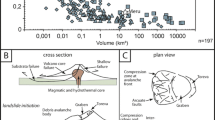Abstract
The depositional features of two valley-filling debris avalanche deposits were studied to reveal their transportation and depositional mechanisms. The valley-filling Iwasegawa debris avalanche deposit (ca. 0.1 km3) is distributed along the valleys at the southeastern foot of Tashirodake Volcano, northern Honshu, Japan. Debris-avalanche blocks range in size from <35 m proximally to <10 m in the distal zone and consist dominantly of fragile materials. Debris-avalanche matrix percentages increase from 35–60% in the proximal zone to 95% in the distal zone. The debris-avalanche matrix is greater in volume (80–90%) at the bottom and margins of the deposit. Normal grading of large clasts and reverse grading of wood logs and branches occur within the debris-avalanche matrix. Preferred orientation of 311 wood logs and branches within the deposit coincide with the interpreted local flow direction. The basal part of the deposit is characterized by (1) erosional features and incorporated clasts of underlying material; (2) a higher proportion (30–50%) of incorporated clasts than the upper part; and (3) reverse grading of clasts.
The valley-filling Kaida debris avalanche deposit (50 000 y B.P., >0.3 km3) is distributed along the valleys at the eastern-southeastern foot of Ontake Volcano, central Japan. Debris-avalanche blocks range in size from <25 m proximally to <7 m in the medial zone. Debris-avalanche matrix percentages increase from 50–70% in the proximal zone to 80% in the distal zone. The debris-avalanche matrix is more abundant (80–90%) at the bottom part of the deposit. Deformation structures observed in the debris-avalanche blocks include elongation, folding, conjugate reverse faults, and numerous minor faults in unconsolidated materials. Lithic components within the debris-avalanche matrix tend to have a higher percentage of plucked clasts from the adjacent underlying formations.
A Bingham "plug flow" model is consistent with the transportation and depositional mechanisms of the valley-filling debris avalanches. In the plug of the debris avalanche, fragile blocks were transported without major rupturing due to relatively small shear stresses in regions of small strain rate. The debris-avalanche matrix was mainly produced by shearing at the bottom and margins of the avalanche. Valley-filling debris avalanches tend to have smaller debris-avalanche blocks and larger amounts of debris-avalanche matrix than do unconfined debris avalanches. These differences may be due to disaggregation of debris-avalanche blocks by shearing against valley walls and interaction between debris-avalanche blocks and valley walls. Oriented wood logs and branches, reverse grading of clasts at the base, and a higher proportion of incorporated clasts at the base are interpreted to result from shearing along the bottom and valley walls.
Similar content being viewed by others
Author information
Authors and Affiliations
Additional information
Received: 25 March 1998 / Accepted: 10 October 1998
Rights and permissions
About this article
Cite this article
Takarada, S., Ui, T. & Yamamoto, Y. Depositional features and transportation mechanism of valley-filling Iwasegawa and Kaida debris avalanches, Japan. Bull Volcanol 60, 508–522 (1999). https://doi.org/10.1007/s004450050248
Issue Date:
DOI: https://doi.org/10.1007/s004450050248




